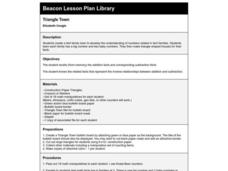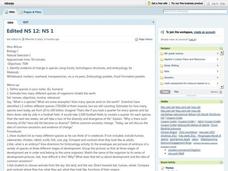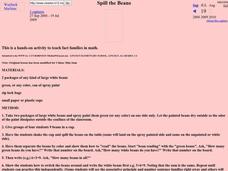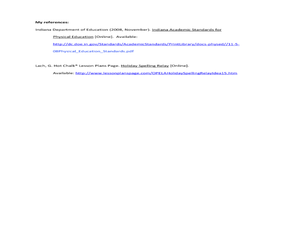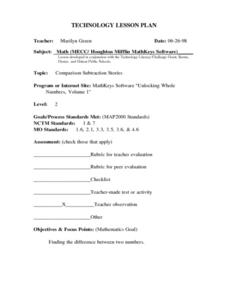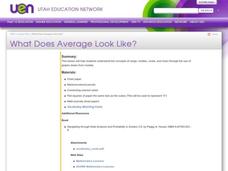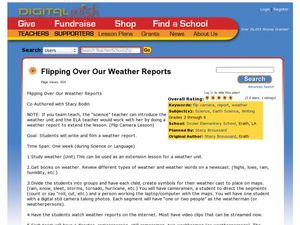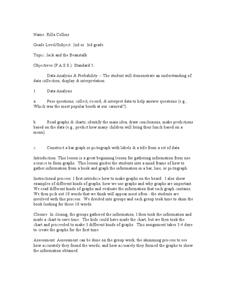Curated OER
Subtraction Math
In this subtraction math worksheet students count the number of shapes in the first group then subtract the number of shapes in the second group. This is an easy beginning subtraction page.
Curated OER
Rate Determining Step and Catalyst Activity
Learners work in groups to stuff as many envelopes as they can in 3-5 minutes. They use an assembly line method. Envelope stuffing is compared to a chemical reactions. The idea of catalyst is considered, and students determine a way to...
Curated OER
Usage and Interpretation of Graphs
Students explore graphing. In this graphing lesson, students predict how many shoe eyelets are present in the classroom. Students count eyelets and work in groups to organize and chart the data collected. Students put all the data...
Curated OER
Triangle Town
Second graders create a fact family town to develop the understanding of numbers related in fact families. They learn each family has a big number and two baby numbers. They make triangle shaped houses for their facts.
Curated OER
Introduction to Organs/Organ Systems via Frog Dissection
Students are to create, in groups of four, the insides of a frog. This is in preparation for the frog dissection that will follow this introductory lesson. Students can begin predicting what the inside of the frog will look like prior to...
Curated OER
Natural Selection
Students estimate how many different species of organisms inhabit the Earth. In groups, they match the pictures of embryos at the different stages of development. They compare and contrast animals from the sky, land, and water and...
Curated OER
How to Build an Electric Motor
Sixth graders build a working motor. In this lesson on motors, 6th graders use an inquiry method of learning to discover how to create a working electric motor with the supplies given to them. The teacher will guide them as needed....
Curated OER
Bird Beaks
Young scholars discover the beaks of birds. In this biology lesson plan, students explore how many different birds can live in the same geographical area because they are adapted to eat different organisms.
Curated OER
Spill the Beans
Learners explore the meaning of a fact family. In this Math lesson, students work in small groups to create their own fact family based on color of beans. The beans are colored and represent a given value. Learners discover the...
Curated OER
A Picture's Worth a Thousand Words
Students analyze the numbers of male vs female administrators and teachers from their school. In this gender equality lesson plan, students use school yearbooks from the 1950's threw present to count how many male vs. female teachers,...
Curated OER
Place Value: Tens and Ones
In these recognizing tens and ones worksheets, students count the rods and units and write the numbers in the tens and ones columns, write the correct numbers for the given tens and ones, covert words to the correct numerals, and...
Curated OER
Interdisciplinary Lesson Plan
Third graders study Thanksgiving. In this physical education and spelling lesson, 3rd graders play a race game by being the first group who can spell the word Thanksgiving first.
Curated OER
VARVES: Dating Sedimentary Strata: Geology, Paleontological Patterns
Students count the number of varves (annual layers of sediment) in shale billets, taken from the Green River Formation in Wyoming. The count is then extended to reflect the entire 260 meters of sediments where the billets originated.
Curated OER
Bug Sweep
Students observe and categorize insects. In this insects science lesson plan, students create a bug catcher out of a coat hanger and plastic bag, then collect bugs from the schoolyard. Students count and categorize the insects according...
Curated OER
Math
Students solve addition, subtraction, multiplication, and division problems that focus on serving size and counting 5 A Day.
Curated OER
Predator-Prey Simulation
Students simulate a predator-prey interaction in an ecosystem. Students use different size squares cut from paper to represent predators and prey. They simulate the interactions of the species by following instructions for the capture of...
Curated OER
Make That Shot!
Young scholars figure out basic percentages by shooting paper balls into a basket, recording results, and calculating individual and team percentages for ten shots.
Curated OER
Comparison Subtraction Stories
Second graders create stories that model comparison subtraction while using the environmental mats. They suggest situations in which they compare numbers. For example, if one student has 6 nickels and another child has 14 nickels,...
Curated OER
Study Buddies: Part of a Set
In this math worksheet, students will work with a coach to describe a group of marbles as a fraction. Students will follow a step-by-step process and notes are provided for the coach.
Curated OER
Reading Chemical Formulas
Young scholars interpret basic chemical formulas. When class begins, students interpret a "chemical formula" for fruit salad. After they interpret the recipe, young scholars use the same strategies to identify chemical formulas. They...
Curated OER
What Does Average Look Like?
Fifth graders explore the concepts of range, median, mode, and mean through the use of graphs drawn from models. They use manipulatives to represent data they have collected within their groups, and compare the differences between mode,...
Curated OER
Flipping Over Our Weather Reports
Young scholars create their own weather report. In this weather lesson, students work in groups to predict the weather for three days and create their own video. They have a director, camera-person, still cameraman, and two...
Curated OER
Jack and the Beanstalk Math
Students listen to Jack and the Beanstalk and determine what they think are the most common words. In this Jack and the Beanstalk lesson, students reread the story, count the words they chosen and graph those words. Students graph...
Curated OER
Radio Free School
Students explore radio news formats, styles, and sequences, and then write segments for a student-centered news radio program. In small groups, students develop and write news segments for a student-centered radio program.



